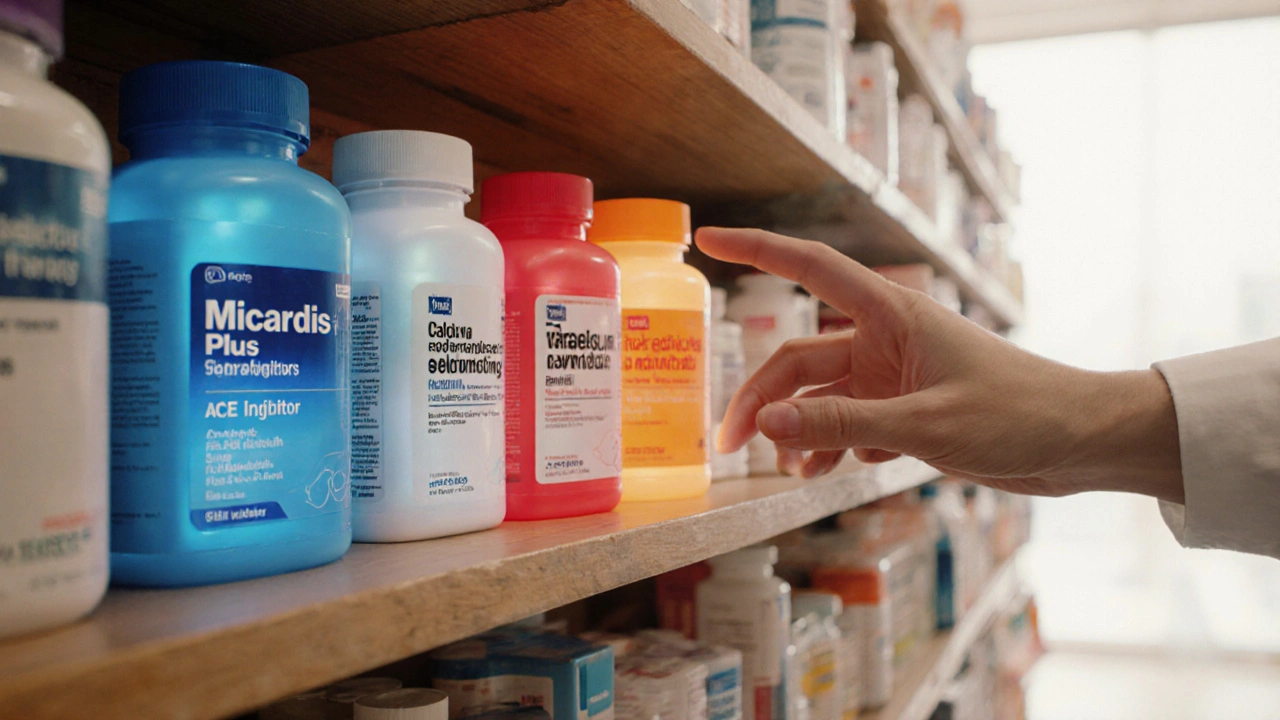
Micardis Plus vs. Other Hypertension Combo Pills
Compare Medication Effects
Select your current medication and see how it compares:
Micardis Plus is a fixed‑dose combination tablet that contains telmisartan (an angiotensin II receptor blocker) and hydrochlorothiazide (a thiazide diuretic). It is approved for treating high blood pressure (hypertension) in adults who need both blood‑pressure lowering mechanisms in one pill.
TL;DR
- Micardis Plus blends an ARB with a thiazide diuretic for strong, once‑daily control.
- Key rivals include Losartan/HCTZ (Hyzaar), Olmesartan/HCTZ, and Exforge (Amlodipine/Valsartan).
- Side‑effects are mostly mild - occasional dizziness or electrolyte changes.
- Choose Micardis Plus if you need an ARB‑based combo and have no severe kidney issues.
- Always pair medication with lifestyle changes for best results.
How Micardis Plus Works
Telmisartan blocks the angiotensin II type 1 receptor, preventing the hormone from tightening blood vessels. Hydrochlorothiazide reduces fluid volume by increasing urinary sodium excretion. Together, they attack high blood pressure from two angles: vasodilation plus volume reduction.
Clinical trials (e.g., the ASCOT‑BP study) showed that telmisartan‑based combos cut cardiovascular events by about 10‑15% compared with monotherapy. The thiazide component adds roughly 5‑8mmHg of systolic reduction, making the combo especially useful for patients whose blood pressure is still high on a single agent.
Key Attributes of Micardis Plus
- Dosage forms: 40mg/12.5mg and 80mg/12.5mg tablets.
- Approved indication: Essential hypertension in adults.
- Typical once‑daily dosing: Morning, with or without food.
- Major contraindications: Severe renal impairment (eGFR <30mL/min), pregnancy, and known hypersensitivity to either component.
- Common side‑effects: Light‑headedness, increased urination, electrolyte imbalance (especially low potassium).
Head‑to‑Head: Micardis Plus vs. Popular Alternatives
Below is a quick‑look comparison of the most frequently prescribed ARB‑diuretic combos and a few non‑ARB options that often appear in treatment guidelines.
| Product | Components | Typical Daily Dose | Approval Year (US) | Notable Contra‑indications |
|---|---|---|---|---|
| Micardis Plus | Telmisartan+Hydrochlorothiazide | 40‑80mg/12.5mg | 2009 | Severe renal impairment, pregnancy |
| Hyzaar | Losartan+Hydrochlorothiazide | 50‑100mg/12.5mg | 2006 | Severe renal impairment, potassium‑sparing drugs |
| Olmesartan/HCTZ | Olmesartan+Hydrochlorothiazide | 20‑40mg/12.5mg | 2008 | History of sprue‑like enteropathy, severe renal disease |
| Exforge | Amlodipine+Valsartan | 5‑10mg/160‑320mg | 2009 | Severe aortic stenosis, pregnancy |
| Lisinopril | ACE inhibitor (monotherapy) | 10‑40mg once daily | 1987 | History of angio‑edema, pregnancy |

Pros and Cons of Micardis Plus
Pros
- Strong dual mechanism - often enough to achieve target BP without adding a third drug.
- Once‑daily dosing improves adherence.
- Telmisartan has a long half‑life (~24h) and is less prone to food interactions.
- Lower incidence of cough compared with ACE inhibitors.
Cons
- Thiazide component can cause electrolyte shifts; patients need periodic potassium checks.
- Not ideal for patients with severe chronic kidney disease (CKD stage4‑5).
- Higher cost than generic separate tablets in some markets.
When to Choose Micardis Plus Over Other Regimens
If a patient is already on an ARB and a thiazide diuretic but takes them separately, switching to Micardis Plus simplifies the regimen. It also shines for:
- Those who experience cough with ACE inhibitors (telmisartan avoids that).
- Patients with modestly elevated potassium who need a thiazide rather than a potassium‑sparing diuretic.
- People who prefer a single pill to reduce pill burden.
Conversely, consider alternatives when:
- Severe renal insufficiency is present - an ACE inhibitor with careful dosing may be safer.
- Opposing side‑effect profiles, such as peripheral edema (more common with calcium‑channel blockers like Exforge).
- Cost constraints push you toward generic monotherapies.
Practical Tips for Starting Micardis Plus
- Check baseline electrolytes (especially potassium) and renal function.
- Start with the lower dose (40mg/12.5mg) if the patient is naïve to ARBs or thiazides.
- Advise patients to rise slowly from sitting to standing to reduce dizziness.
- Schedule follow‑up BP check in 2‑4 weeks, and repeat labs at 6‑8 weeks.
- If potassium drops <3.5mmol/L, consider adding a potassium‑sparing agent or switching to a lower‑dose thiazide.
Related Concepts You’ll Want to Explore Next
Understanding Micardis Plus fits into a bigger picture of hypertension management. You may also want to read about:
- Blood‑pressure targets for different risk groups (e.g., American Heart Association guidelines).
- Role of lifestyle changes - DASH diet, sodium restriction, regular exercise.
- Renal‑protective strategies when using ARBs or ACE inhibitors.
- How combination therapy impacts cardiovascular outcomes in long‑term studies.
Frequently Asked Questions
Can I take Micardis Plus if I’m already on an ACE inhibitor?
Switching from an ACE inhibitor to Micardis Plus is common when patients develop a dry cough. Stop the ACE inhibitor (usually after a 24‑hour washout) and start Micardis Plus at the appropriate dose. Always consult your clinician for a personalized taper plan.
What should I watch for regarding electrolyte changes?
Hydrochlorothiazide can lower potassium and magnesium. Common signs include muscle cramps, irregular heartbeat, or fatigue. Routine labs every 1‑2 months during the first three months help catch imbalances early.
Is Micardis Plus safe during pregnancy?
No. Both telmisartan and hydrochlorothiazide are classified as pregnancy‑category D. They can harm the fetus, especially in the second and third trimesters. Women of child‑bearing age should use effective contraception while on this drug.
How does Micardis Plus compare cost‑wise to taking the components separately?
In the U.S., the combo pill often costs a bit more than two generic tablets bought separately, but insurance formularies may favor the branded combo. For uninsured patients, pharmacies sometimes offer discount cards that bring the price close to generic levels.
Can I use Micardis Plus with other blood‑pressure drugs?
Yes, but only under medical supervision. Adding a calcium‑channel blocker (like amlodipine) or a beta‑blocker is common for resistant hypertension. Avoid stacking multiple thiazides or other ARBs to prevent overdose.



Just switched to Micardis Plus and feeling 😊.
Micardis Plus is totally overrated. It’s just another ARB combo that nobody needs.
The pharmaceutical industry has orchestrated a comprehensive campaign to promote fixed‑dose combination tablets such as Micardis Plus. Historical documents reveal that regulatory agencies have been pressured to fast‑track approval processes for these products. This pressure is justified by claims of improved compliance, yet the underlying motive appears to be market domination. By bundling telmisartan with hydrochlorothiazide, manufacturers secure patents that extend beyond the life of the individual components. Such patent evergreening strategies limit the entry of low‑cost generics into the market. Moreover, clinical trial data released for these combos often omit long‑term safety endpoints. The omission is not accidental; it obscures potential renal and electrolyte complications that may emerge after years of therapy. Independent researchers have raised concerns about a subtle increase in adverse cardiovascular events in certain subpopulations. These concerns have been downplayed in press releases that emphasize modest blood‑pressure reductions. The narrative presented to physicians centers on convenience, while the economic incentives remain concealed. Insurance formularies further entrench these products by offering tier‑1 coverage, thereby discouraging alternative monotherapies. Patients, trusting the healthcare system, adopt these combos without full awareness of the trade‑offs. Consequently, the public health landscape experiences a gradual shift toward polypharmacy. Vigilant oversight and transparent disclosure are essential to counteract this covert agenda. Until such measures are instituted, clinicians must scrutinize the evidence and counsel patients accordingly.
I dont think the article covers the real side effect risk, especially the subtle electrolyte shifts that can cause major issues later.
It’s important to monitor electrolytes regularly when using any thiazide‑based combo; discussing lab results with your doctor can help catch issues early.
Correction: “I don’t think the article covers the real side‑effect risk, especially the subtle electrolyte shifts that can cause major issues later.”
Thank you for the clarification, Ada. Monitoring labs is indeed a prudent step for anyone on combination therapy.
Micardis Plus works well for many, but remember lifestyle changes matter too 🌱.
Indeed, diet, exercise, and stress management are crucial; they complement pharmacotherapy; adherence improves outcomes; stay proactive!
Hypertension, often termed the “silent killer,” epitomizes a condition in which physiological balance is subtly disrupted over time. The interplay between vascular resistance and cardiac output underscores a complex homeostatic system that can be perturbed by genetic, environmental, and behavioral factors. While pharmacological interventions such as Micardis Plus target specific mechanistic pathways, they represent merely one facet of a broader therapeutic tapestry. Philosophically, the reliance on medication invites reflection on the human desire to seek external solutions to internal dysregulation. Yet, the mind‑body connection suggests that psychological stressors can potentiate arterial stiffness, thereby diminishing the sole efficacy of any drug regimen. Consequently, a holistic approach that integrates mindfulness, nutrition, and physical activity may synergize with antihypertensive agents. Empirical studies have demonstrated that patients who engage in regular aerobic exercise experience additive reductions in systolic pressure beyond pharmacotherapy alone. Moreover, dietary patterns rich in potassium and low in sodium have been correlated with favorable renin‑angiotensin system modulation. It is therefore incumbent upon clinicians to convey that medication adherence, while essential, does not obviate the need for lifestyle vigilance. In the broader societal context, public health policies that promote accessible greenspaces and affordable healthy foods can alleviate the collective burden of hypertension. Ultimately, the pursuit of optimal blood‑pressure control is an odyssey that intertwines science, personal responsibility, and communal support. By embracing this multifaceted perspective, patients may attain not only lower numbers on a cuff but also an enhanced quality of life.
Wow, that was a deep dive! i cant even begin to wrap my head around how many layers there are-it's like a conspiracy of numbers and pills.
The mechanistic synergy between an ARB and a thiazide diuretic exemplifies a rational polypharmacy strategy, leveraging complementary pharmacodynamics to achieve target MAP reduction while mitigating compensatory RAAS activation.
Bravo to everyone contributing such vibrant insights; the discourse is as colorful as a rainbow after a storm, and it truly enriches our collective understanding!